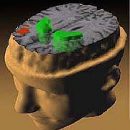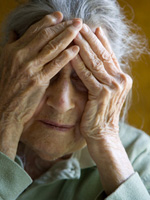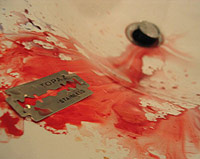Neurosis is the most common type of psychogeneration (painful states caused by the impact of psychotrauming factors); They are characterized by the passage of mental disorders (obsessive states, hysterical manifestations, etc.), critical attitude to them, preservation of the mind of the disease, the presence of somatic and vegetative violations.
Content
Development of neurosis
The development of neurosis occurs in different ways. Along with short-term neurotic reactions, it is often observed and the protracted flow of them, not accompanied, however, pronounced violations of behavior. Neurotic reactions usually occur on relatively weak, but long-acting stimuli, leading to constant emotional voltage or internal conflicts (events requiring difficult alternative solutions, situations that generate the uncertainty of the situation pose a threat to the future). Along with psychogenic impacts, an important role in the genesis of neuroses belongs to a constitutional predisposition.
Three types of neurosis
- neurasthenia,
- Neuroses of obsessive states,
- hysteria.
Neurasthenia (asthenic neurosis). In the first place in the clinical picture are asthenic manifestations: increased mental and physical fatigue, scatletination, disgrace, decrease in performance, the need for a long rest, not given, however, the full restoration of forces. The most typical complaints of the decline of strength, the absence of cheerfulness, energy, on low mood, branched, weakness, intolerance of ordinary loads. Increased mental depletion is combined with excessive excitability (phenomena of irritable weakness), hyperesthesia. Patients are unrestrained, hot-tempered, complain about the constant feeling of internal stress; Even phone calls, minor misunderstandings that have previously held unnoticed, now cause a rapid emotional reaction, quickly running out and often ending tears. To the most frequent neurasthenic symptoms also include headaches, sleep disorders, diverse somadegotative disorders (hyperhydrosis, violations of the functions of the cardiovascular system, gastrointestinal tract, respiratory organs, sexual function, etc.).
 Neuroses of obsessive states Manifested by numerous obsessions, although the picture of each particular neurosis is usually relative to the monomorphne. In the circle of obsessive-phobic disorders, agoraphobia, claustrophobia, fear of transport, public speeches, noseophobia (cardiophobia, carcercipobia, etc.) The neurosis of obsessive states compared to other neurosis reveals a significantly more pronounced tendency to a protracted flow. If there is no significant expansion of symptoms, then the patients are gradually adapted to phobiam, they are involved in avoiding situations in which fear arises; The disease thus does not lead to sharp violations of life.
Neuroses of obsessive states Manifested by numerous obsessions, although the picture of each particular neurosis is usually relative to the monomorphne. In the circle of obsessive-phobic disorders, agoraphobia, claustrophobia, fear of transport, public speeches, noseophobia (cardiophobia, carcercipobia, etc.) The neurosis of obsessive states compared to other neurosis reveals a significantly more pronounced tendency to a protracted flow. If there is no significant expansion of symptoms, then the patients are gradually adapted to phobiam, they are involved in avoiding situations in which fear arises; The disease thus does not lead to sharp violations of life.
Hysteria. In most cases, the clinical picture is determined by motor and sensory disorders, as well as the disorders of vegetative functions that simulate somatic and neurological diseases (conversion hysterium). The group of motor disorders, on the one hand, includes hysterical paresses and paralysis, and on the other - hypercines, teaks, rhythmic tremor, increasing when fixing attention, and a number of other involuntary movements. There are hysterical attacks. Sensitivity disorders include anesthesia (more often arising «amputation type» - as «stocking», «Gloves»), hyperesthesia and hysterical pain (most typical headache, defined as «hoop, tightening forehead and whiskey», «Drunk nail» and etc.). Non-believees include some forms of nervous anorexia, stuttering, enurged.
In neurosis, in contrast to psychosis, the feeling of alien to painful disorders is always preserved, the desire to resist. The negros-like states observed within endogenous psychosis are characterized by a greater polymorphism of manifestations and a tendency to further expand symptoms, abstract, bizarre, and sometimes ridiculous content of fears and obsessions, unmotivated anxiety.
Treatment of neurosis
Treatment complex, includes therapy with psychotropic drugs, psychotherapy, having a goal to resolve a conflict situation, generalifying funds, physiotherapy. Sanatorium-resort treatment is also shown; With persistent neurotic states accompanied by affective (depressive) disorders and resistant to outpatient care, hospitalization is shown.
In drug treatment of neuroses, tranquilizers diazepam (sadocent), sybazone, relaignation, oxaispam (pelvis), chloridiazepoxide (helium), 7-50 mg / day, 1-3 mg / day, Meprotan (Meprobamat), 200-800 mg / day. In more severe cases (resistant obsessions, massive hysterical disorders, etc.) The intramuscular, and in the hospital - and intravenous drip administration of tranquilizers (diazepams, chlordiazepoxide) or the purpose of neuroleptics in small doses of Etherazin - 4-12 mg / day, chlorprotine - 15-20 mg / day, thiuridazine (Sonpax) -10-50 mg / day, iriable (properiatriciazine) - 10-20 mg / day, eglonyl - 100-400 mg / day, as well as preparations of prolonged effects Fluorfena-Zin-Decanoat (modean-depot) -12.5-25 mg, floiring- 2 -4 mg 1 time in 1-2 weeks. In patients with a predominance of asthenic manifestations, a combination of tranquilizers with piracetam (nootropyl) or aminalon.
With pronounced affective (depressive) disorders show a combination of tranquilizers with antidepressants (amitriptyline in combination with chloridiazepoxide, etc.). In cases with persistent sleep disorders, nitrazempam (Enowlifing, Radedorm) are prescribed 5-15 mg, relators, fondasses of 0.5-1.5 mg, 10-10 mg were teenenen, chlorprotine at 15 mg. Neurotic reactions in most cases reversible.
Prevention of neuroses
Includes a number of social and psycho-generic events, including the creation of favorable family and labor conditions, rational professional orientation, the prevention of emotional overvoltage, the elimination of professional harm and others.









